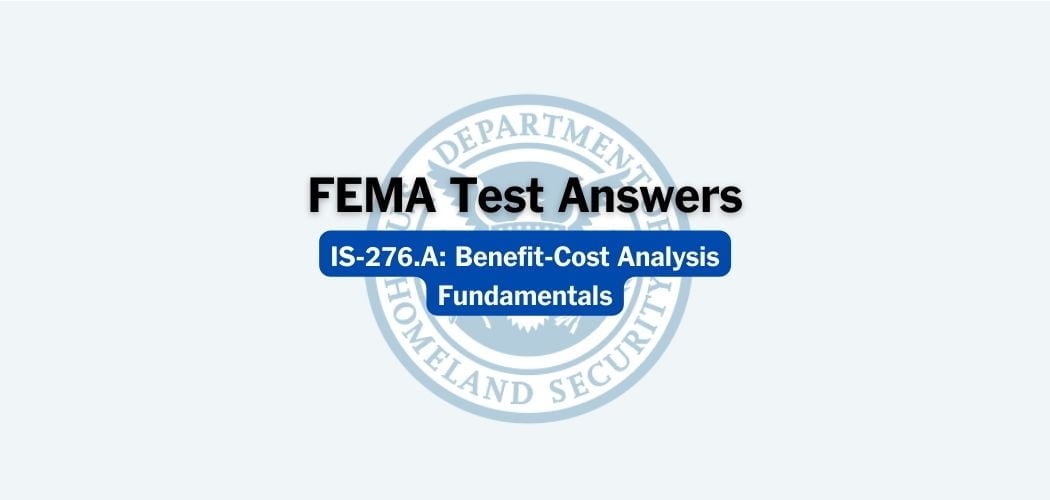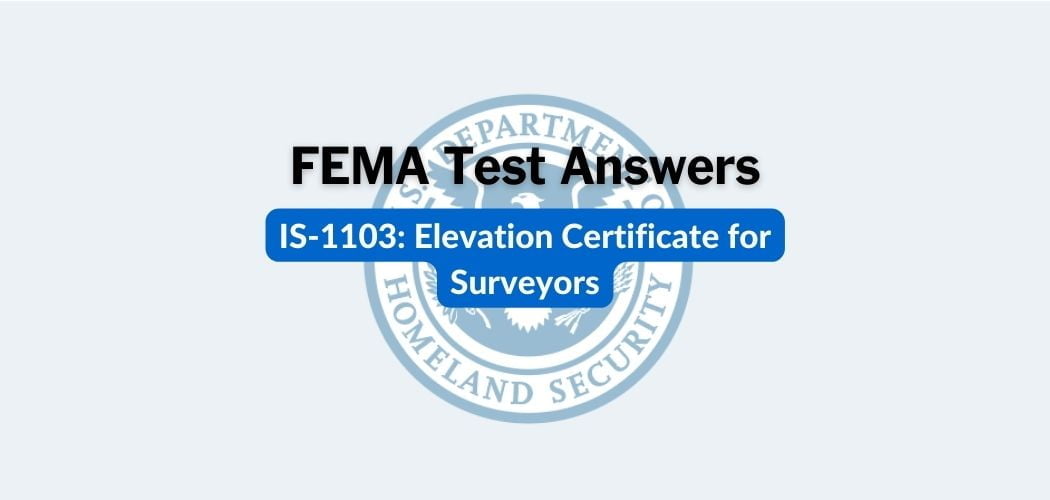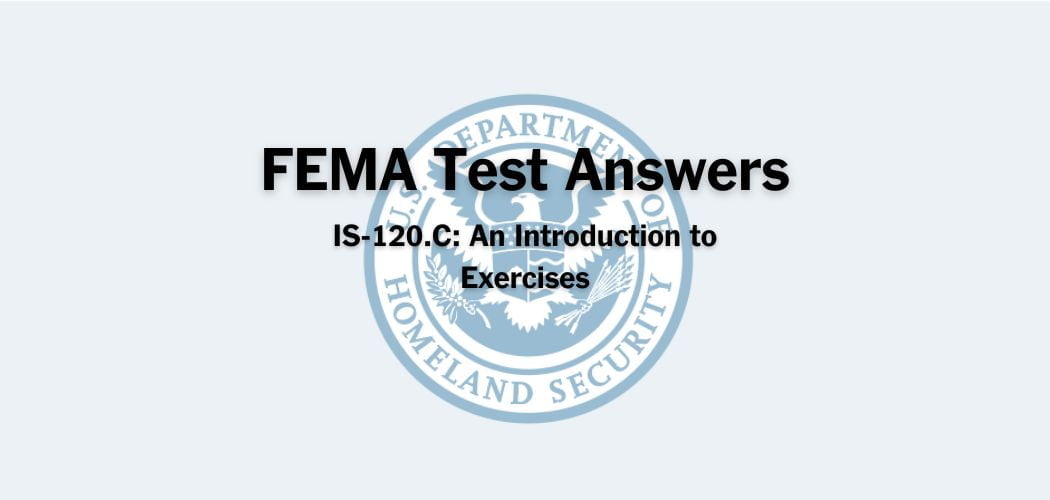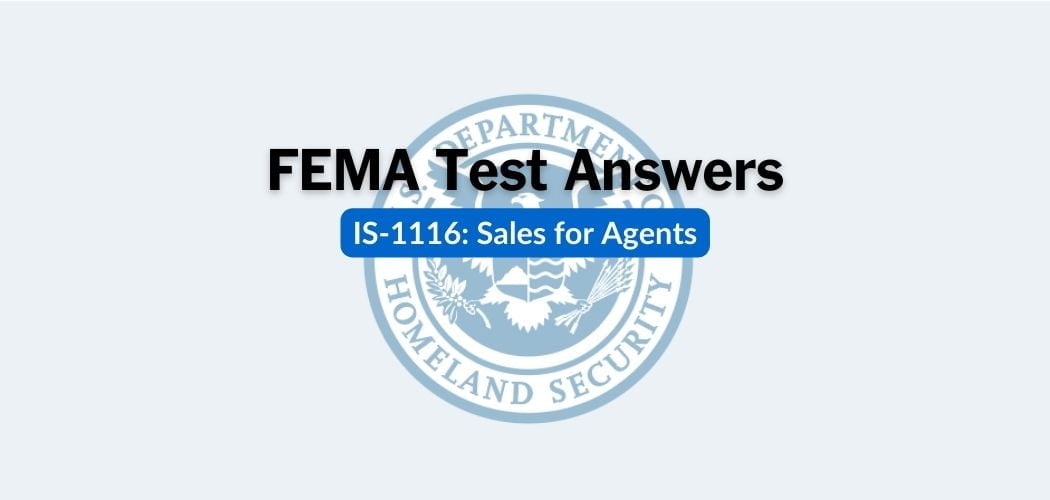Overview: The FEMA IS-1000 course was published on 2/28/2019 to provide an overview of Public Assistance project eligibility. By the end of the course, State, Local, Indian Tribal, and Territorial Applicants and Recipients will be able to understand all aspects of Public Assistance Program and project eligibility.
FEMA IS-1000 test answers
Each time this test is loaded, you will receive a unique set of questions and answers. The test questions are scrambled to protect the integrity of the exam.
Question 1. Which of the following statements about Applicant (Force Account) Equipment and Purchased Equipment is true?
A. FEMA provides Public Assistance funding for the use of Applicant-owned equipment (force account equipment) only based on FEMA-established equipment rates.✅
B. equipment rates are only applied to the time the Applicant is actually operating equipment.
C. costs associated with mobilizing equipment to a project site and for standby time are not eligible.
D. if the Applicant purchases equipment that it justifiably needs to respond effectively to the incident, FEMA provides Public Assistance funding for only the purchase price
Question 2. FEMA does not provide Public Assistance funding for the repair of damage caused by:
A. flooding
B. tornadoes
C. deterioration✅
D. mold
Question 3. The Governor or Tribal Chief Executive must request a declaration from the President through FEMA within ____ of the incident.
A. 90 days
B. 15 days
C. 60 days
D. 30 days✅
Question 4. There are several factors that need to be considered when determining if work may be eligible for Public Assistance. At a minimum, work must meet each of the following general criteria, except:
A. be the legal responsibility of an eligible Applicant
B. be the legal responsibility of an eligible Recipient✅
C. be located within the designated area
D. be required as a result of the declared incident
Question 5. All of the following are components of eligibility, except:
A. facility
B. Recipient✅
C. work
D. cost
Question 6. Evaluating facility eligibility is not a necessary step for most Emergency Work State, Territorial, Tribal, and Local Government Applicants. This statement is an example of:
A. An exception to the standard Eligibility Pyramid✅
B. The building blocks of the Eligibility Pyramid
C. A demonstration that each component of the pyramid is eligible
D. Providing supporting documentation
Question 7. Flood control, navigation, irrigation, reclamation, public power, sewage treatment, and collection are examples of:
A. ineligible public facilities
B. ineligible Private Nonprofit facilities
C. eligible Private Nonprofit facilities
D. eligible public facilities✅
Question 8. The President provides authorization for Federal assistance through two types of declarations. This declaration is an incident that the President determines warrants only supplemental emergency assistance to save lives and protect property, public health, and safety, or to lessen or avert the threat of a catastrophe.
A. Alternative Declaration
B. Minor Disaster Declaration
C. Emergency Declaration✅
D. Major Disaster Declaration
Question 9. The second category of work under Emergency Work is Category B:
A. Primary protective measures
B. Secondary protective measures
C. Temporary protective measures
D. Emergency protective measures✅
Question 10. Restoration of water control facilities is a primary example of:
A. Temporary work
B. Eligible work
C. Permanent work✅
D. Emergency work
Question 11. Within Emergency Work are two categories of work: Category A and Category B. Category A is:
A. emergency protective measures
B. immediate threats
C. restoration of bridges
D. debris removal✅
Question 12. Before FEMA can provide any assistance through the Public Assistance Program, the declared State, Territorial, and/or Tribal Government must submit form _________, which is an Application for Federal Assistance.
A. SF 425
B. SF 424✅
C. SF 423
D. SF 422
Question 13. FEMA provides Public Assistance funding for contract costs based on the terms of the contract if the Applicant meets __________ procurement and contracting requirements.
A. State
B. Tribal
C. Local
D. Federal✅
Question 14. Permanent Work addresses the restoration, while Emergency work addresses:
A. restoration of buildings/equipment
B. restoration of water control facilities
C. restoration of bridges
D. immediate threats✅
Question 15. Extraordinary costs include the following, except:
A. hazardous duty pay
B. regular pay✅
C. night-time and weekend differential pay
D. call-back pay
Question 16. Select the complete list of eligible Applicants.
A. Tribal Governments, Local Governments, certain Private Nonprofit Organizations
B. State and Territorial Governments, Tribal Governments, Local Governments
C. State and Territorial Governments, Tribal Governments, Local Governments, and certain Private Nonprofit Organizations✅
Question 17. This is the span of time during which the federally declared event occurs. This period varies in length, depending on the type of incident.
A. Incident Period✅
B. Designation Period
C. Emergency Period
D. Declaration Period
Question 18. The following is not a Procurement Requirement for State and Territorial Applicants
A. must use their own documented procurement procedures that reflect applicable State, Territorial, Tribal, and Local government laws and regulations✅
B. ensure that every purchase order or other contract includes any clauses required by 2 Code of Federal Regulations – 200.326.
C. comply with 2 Code of Federal Regulations – 200.322, Procurement of recovered materials
D. follow the same policies and procedures they would use for procurements with non-Federal funds
Question 19. Category A debris removal activities are generally eligible when:
A. there is debris removal from federally maintained navigable channels and waterways
B. the work eliminates immediate threats to lives, public health, and safety✅
C. debris is placed on the public rights-of-way from commercial properties
D. debris materials are related to the construction, repair, or renovation of either residential or commercial structures
Question 20. Non-State Applicants must use one of the following procurement methods:
A. informal advertising
B. complacent proposal
C. large purchase procedure
D. micro–purchases✅
Question 21. This legislation authorizes the President to provide Federal assistance when the magnitude of an incident or threatened incident exceeds the affected State, Territorial, Tribal, and Local government capabilities to respond or recover.
A. National Incident Management System
B. FEMA Qualification System
C. Homeland Security Act
D. Stafford Act✅
Question 22. Eligibility of mixed-use private nonprofit facilities depends on the ____ use of the facility, which is determined by the amount of physical space dedicated to eligible and ineligible services.
A. functional
B. eligible
C. secondary
D. primary✅
Question 23. A private nonprofit organization that provides a non-critical, but essential, government service and is open to the general public includes all of the following, except:
A. Food assistance programs
B. Councils of governments✅
C. Assisted living
D. Child care
Question 24. Emergency Work addresses:
A. restoration of buildings/equipment
B. restoration of water control facilities
C. debris removal✅
D. restoration of bridges
Question 25. This type of work must be done immediately to:– Save lives– Protect public health and safety– Protect improved property– Eliminate or lessen an immediate threat of additional damage
A. Temporary work
B. Eligible work
C. Permanent work
D. Emergency work✅
Question 26. All of the following are conditions for eligible removal of privately owned vehicles and vessels, except:
A. the vehicle or vessel is believed to contain hazardous materials✅
B. the Applicant verifies the chain of custody of the vehicle or vessel
C. the vehicle or vessel blocks access to a public-use area
D. the vehicle or vessel is abandoned and the Applicant is unable to identify the owner
Question 27. Permanent Work addresses:
A. emergency protective measures
B. immediate threats
C. restoration of bridges✅
D. debris removal
Question 28. Which of the following statements about prisoner labor cost is true?
A. FEMA may provide Public Assistance funding for prisoner labor costs based on the rate that the Applicant normally pays prisoners and dividing that number by 2.
B. FEMA may provide Public Assistance funding for prisoner labor costs based on the rate that the Applicant normally pays prisoners and subtracting that number by 2.
C. FEMA may provide Public Assistance funding for prisoner labor costs based on the rate that the Applicant normally pays prisoners.✅
D. FEMA may provide Public Assistance funding for prisoner labor costs based on the rate that the Applicant normally pays prisoners and multiplying that number by 2.
Question 29. The following is true about Procurement Requirements for Non-State Applicants
A. must use their own documented procurement procedures that reflect applicable State, Territorial, Tribal, and Local government laws and regulations✅
B. ensure that every purchase order or other contract includes any clauses required by 2 Code of Federal Regulations – 200.326.
C. comply with 2 Code of Federal Regulations – 200.322, Procurement of recovered materials
D. follow the same policies and procedures they would use for procurements with non-Federal funds
Question 30. Examples of generally eligible State and Territorial government Applicants are:
A. Councils of governments and Regional interstate government entities
B. District of Columbia and school districts
C. District of Columbia and American Samoa✅
D. Counties and parishes and school districts
Question 31. All of the following help FEMA determine reasonableness of cost escalation, except:
A. upgrades made by the Applicant to existing facilities✅
B. shortages in equipment, materials, supplies, labor, or contractors
C. whether or not the Applicant deviated from its established practices
D. project-specific complexities (i.e. environmental or historic issues)
Question 32. To be eligible, a facility must have been in active use at the start of the incident period. Inactive facilities are not eligible unless one of the following conditions is met:
A. the Applicant firmly established future active use in an approved budget✅
B. the Recipient demonstrated intent to begin use
C. the Recipient established active use in a nonapproved budget
D. the facility was never inactive for repairs or remodeling
Question 33. This statute authorizes FEMA to provide assistance via the Public Assistance Program.
A. National Incident Management System
B. FEMA Qualification System
C. Homeland Security Act
D. Stafford Act✅
Question 34. This cost occurs when bus drivers are prudently deployed to transport evacuees.
A. overtime cost
B. prisoner labor cost
C. straight-time cost
D. stand-by-time cost✅
Question 35. To be eligible, costs must be:
A. prohibited under Federal, State, Territorial, Tribal, or Local government laws or regulations
B. consistent with the Recipient’s internal policies
C. exceeded all applicable credits
D. directly tied to the performance of eligible work✅
Question 36. FEMA determines reasonableness by evaluating whether:
A. the Recipient participated in ethical business practices
B. the Recipient complied with procurement requirements
C. urgent circumstances existed
D. cost escalation was the result of: abundances in equipment, materials, supplies, labor, or contractors✅
Question 37. Which of the following is an example of stand-by-time cost?
A. When first responders are prudently deployed for the purpose of evacuating and the employee performs eligible Emergency Work
B. When the Applicant performs an analysis of the cost of leasing versus purchasing the equipment
C. When a contract or union agreement requires payment for stand-by time✅
D. When bus drivers are prudently deployed to transport evacuees, and the bus is used hourly
Question 38. The following Local governments are examples of Applicants that may be eligible to receive Public Assistance, except:
A. School districts
B. District of Columbia✅
C. Intrastate districts
D. Counties and parishes
Question 39. The second requirement of work eligibility is that it must fall within one of the categories of work. Through the Public Assistance Program, FEMA provides grant funding for:
A. disaster assistance with private housing
B. temporary restoration of inactive damaged facilities
C. emergency protective measures and debris removal✅
D. restoration of single-family homes
Question 40. An eligible public facility is one that a State, Territorial, Tribal, or Local government owns or has legal responsibility for maintaining, including all of the following, except:
A. Parks
B. Assisted living facility, child care facility, and food assistance facility✅
C. Non-Federal-aid street, road, or highway
D. Flood control, navigation, and irrigation



